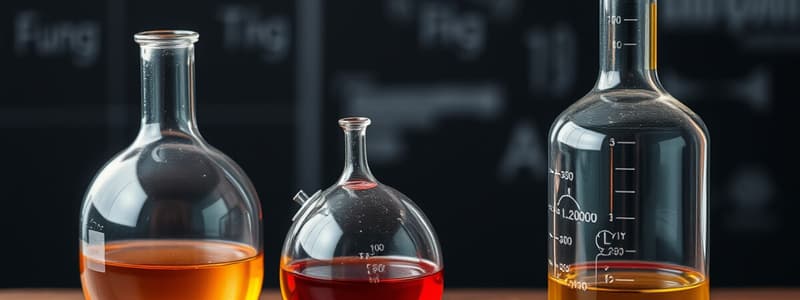Podcast
Questions and Answers
What is stoichiometry?
What is stoichiometry?
Study of quantitative relationships between the amounts of reactants used and the amounts of products formed in a chemical reaction.
Mass of Reactants = _____
Mass of Reactants = _____
Mass of Products
Number of atoms of each element on the reactant side of the equation = _____
Number of atoms of each element on the reactant side of the equation = _____
the number of atoms of each element on the product side of the equation
Number of moles of each element on the reactant side of the equation = _____
Number of moles of each element on the reactant side of the equation = _____
What is a mole ratio?
What is a mole ratio?
In the equation 4Al + 3O₂→ 2Al₂O₃, the mole ratios can be calculated between Al and O₂.
In the equation 4Al + 3O₂→ 2Al₂O₃, the mole ratios can be calculated between Al and O₂.
How do you perform a mole to mole conversion using the mole ratio?
How do you perform a mole to mole conversion using the mole ratio?
How many moles of Al₂O₃ will be produced if there are 3.75 moles of O₂ in the equation 4Al + 3O₂→ 2Al₂O₃?
How many moles of Al₂O₃ will be produced if there are 3.75 moles of O₂ in the equation 4Al + 3O₂→ 2Al₂O₃?
How many moles of CO₂ are produced when 7 moles of C₃H₈ are burned in the reaction C₃H₈ + 5O₂→ 3CO₂ + 4H₂O?
How many moles of CO₂ are produced when 7 moles of C₃H₈ are burned in the reaction C₃H₈ + 5O₂→ 3CO₂ + 4H₂O?
What is the formula for mass to mass conversion?
What is the formula for mass to mass conversion?
How many grams of H₂O are produced if you are given 50 g of NH₄NO₃ in the reaction NH₄NO₃ → N₂O + 2H₂O?
How many grams of H₂O are produced if you are given 50 g of NH₄NO₃ in the reaction NH₄NO₃ → N₂O + 2H₂O?
How do you calculate the theoretical yield of a substance?
How do you calculate the theoretical yield of a substance?
What is the percent yield equation?
What is the percent yield equation?
What defines a limiting reactant?
What defines a limiting reactant?
What is meant by excess reactant?
What is meant by excess reactant?
How much of the excess reactant (S₈) was left after the reaction with Cl₂?
How much of the excess reactant (S₈) was left after the reaction with Cl₂?
Flashcards are hidden until you start studying
Study Notes
Stoichiometry Overview
- The study of quantitative relationships in chemical reactions, involving reactants and products.
Mass Relationships
- Mass of reactants equals mass of products in a reaction.
Conservation of Atoms
- The number of atoms for each element must be equal on both sides of the reaction equation.
Molar Relationships
- The number of moles for each element must also be equal on both sides of the equation.
Mole Ratio
- Derived from the coefficients of balanced chemical equations, used for conversions.
Example of Mole Ratios
- For the equation 4Al + 3O₂ → 2Al₂O₃, various mole ratios can be established:
- 4 moles Al : 3 moles O₂
- 3 moles O₂ : 2 moles Al₂O₃
Mole to Mole Conversion
- Determine moles of an unknown substance using the formula: Moles of Unknown = Moles of Known x Mole Ratio.
Example Problem: O₂ to Al₂O₃ Conversion
- From the equation, if 3.75 moles O₂ are given, 2.50 moles Al₂O₃ are produced.
Example Problem: C₃H₈ to CO₂ Conversion
- Burning 7 moles of C₃H₈ produces 21 moles of CO₂.
Mass to Mass Conversion
- To convert from mass of the Known to the mass of the Unknown, follow: Mass of Known / Molar Mass of Known x Mole Ratio x Molar Mass of Unknown.
Example Problem: NH₄NO₃ to H₂O
- From 50 g of NH₄NO₃, 22.5 g of H₂O are produced.
Mole to Mass Conversion
- Calculated using: Moles Known x Mole Ratio x Molar Mass of Unknown.
Mass to Mole Conversion
- Achieved through: Mass Known / Molar Mass Known x Mole Ratio.
Limiting and Excess Reactants
- Limiting reactant is the one that produces the least amount of product.
- Excess reactant remains un-reacted after the reaction.
Limiting Reactant Problem Example
- In the reaction S₈ + 4Cl₂ → 4S₂Cl₂ with 200 g S₈ and 100 g Cl₂:
- Perform separate calculations to determine S₂Cl₂ production from each reactant.
Mass-to-Mass Calculation Example
- For sulfur, 421 g of S₂Cl₂ can be produced.
- For chlorine, only 190.4 g of S₂Cl₂ can be produced, making Cl₂ the limiting reactant.
Excess Reactant Calculation
- Remaining S₈ after reaction:
- 200 g S₈ supplied, 93.6 g used, leaving 106.4 g in excess.
Percent Yield
- Ratio of actual amount produced to the expected (theoretical) amount, expressed as a percentage.
Theoretical Yield
- Expected production based on stoichiometric calculations.
Actual Yield
- The amount of product produced during an experiment.
Percent Yield Equation
- Percent Yield = (Actual Yield ÷ Theoretical Yield) × 100.
Percent Yield Example Problem: Ag₂CrO₄
- Calculating yield from reaction K₂CrO₄ + 2AgNO₃ → Ag₂CrO₄ involves finding theoretical yield from limiting reactant AgNO₃ first.
- Given 0.500 g of AgNO₃, the theoretical yield calculated is 0.488 g.
- Actual yield of Ag₂CrO₄ is 0.455 g, leading to a percent yield of 93.2%.
Studying That Suits You
Use AI to generate personalized quizzes and flashcards to suit your learning preferences.




